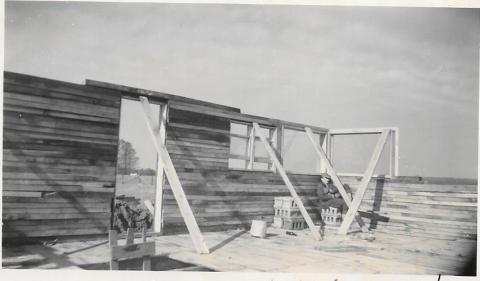Almost Log Cabin
How can something be an “almost log cabin”? Easy, when you have a big enough supply of 3” by 6” lumber. Of course we could have used it for studding, but Dad would hear none of that. Let me tell you about it. A little background first.
After the December 7, 1941 attack on Pearl Harbor, our country had to quickly mobilize manufacturing facilities to produce war materiel. My dad had been a foreman over a bunch of women at the Willow Run Bomber Plant in Ypsilanti. (There's another story there.) We moved to the farm in 1943. Dad, an electrician, found work at the Jackson Bumper Company. No longer making car bumpers (remember them?), they had converted to making bomb casings; not little ones, big ones, about four feet tall. To ship them, a sturdy crating was needed. That is where the 3” by 6” oak lumber came in. They built the crating for the bomb casings as well.
When the war ended in 1945, bumpers went back into production. The lumber sat there on a back lot for quite a while. Finally, it was to be auctioned off to any of their interested employees. My dad was interested as were several others. But Dad was the only one with a vision of what could be accomplished with a lot of 3 by 6s. He bought the whole pile, about 170,000 board feet for $150.00. He was the sole bidder. Dad more than recovered his cost by selling off small lots to several of his co-workers. The remainder, he and my husband, brought home on a trailer. It took several weeks.
Dad had given us an acre of land as a wedding present at the far end of the farm in front of the woodlot of hardwood trees. They hauled the 3 by 6s there and prepared to build our house. It was in early 1947. My dad was of the old school. You did things his way. We were soon reminded of that. He had a definite idea on how our house should be built. My husband went along with his plan. They would lay the 3 by 6s flat and build them up like a log cabin and they would be fastened together with #20 spikes. If you think a #16 nail is big, #20 is bigger and longer. They dipped them in motor oil to make penetration easier. It was hard work using very heavy hammers and lots of elbow grease. This was before the days of electric drills and such.
My cousins, who worked at the local lumber yard with my husband, laughed themselves silly. “Use the 3 by 6s for studding,” they insisted. However, you didn't ever tell my dad what to do. He went ahead with his plan. When the wood had been nailed up to their desired wall height, they laid the ceiling joists and continued up with the roof. Doorways and windows had been framed in as they went. The outside was then covered with the new and very stylish asbestos siding that came in 3 feet long sections. We thought the house looked great. My cousins, not so much.
Not understanding the need for a dead air apace between the outside wall and the interior, they applied wire lath to the inside edge of the 3 by 6s and plastered over that. Wrong. You couldn't get the house warm in winter. The walls even iced up occasionally. My cousins were right. Dad didn't care, his job was done. It had turned out to his satisfaction. There is more to this story that I could tell you at another time if you are interested.
- Log in to post comments
